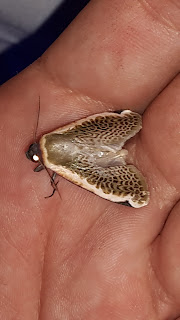Fast forwarding to October 17th, 2015, 353 days after I purchased the book, I find myself on a plane with two birding friends headed for Trinidad....and the Scarlet Ibis. As usual, I had fought for the window seat so I had the best view, and the best chance at seeing the first bird of the trip. As we were approaching Port of Spain, Trinidad, I saw quite a few white wading birds in the coastal marshes, but we were still too far away to get any positive identifications. Then, as we cruised over the mangroves, minutes away from landing, I saw it. A single Scarlet Ibis soared over the mangroves, a bright red bird with a long, decurved bill and black wingtips. I couldn't believe it! Not only had I seen the first identifiable bird of the trip, but it was THE bird I had come all this way to see!
 |
| First views of Trinidad |
Ordering food and finding non-soda beverages took much longer than expected, but finally we were all piled in the van and headed for the Asa Wright Nature Center. By the time we had left the airport area, we all agreed that hiring a driver was one of the best decisions of the whole trip. Due to a strong British influence, driving is on the left side of the road, and the streets are narrow with many inconsiderate and bad drivers. If a driver sees a friend and wants to have a chat, stopping in the middle of the lane as if it is a parking spot seems to be a common practice. Often there were only a few inches between our van and oncoming vehicles In addition, pedestrians were often found walking in the streets regardless if sidewalks were available. Once we got out of the hustle and bustle of Port of Spain and Arima, the mountain roads proved to be an entirely different type of roller coaster. No guardrails and steep drop-offs is something that we had gotten used to in Costa Rica, but here the roads were much narrower, with limited to no visibility around hairpin turns. Seatbelts are only required for the front seats in Trinidad, so wearing one for extra security wasn't even an option for any of us sitting in the back. More than once our driver had to back up or squeeze as far as possible to the outside of a sharp turn (and the cliff edge!) to allow another vehicle to pass with only inches to spare. The wandering dogs and stretches of road construction projects added yet another challenge to getting from one place to another.
 |
| Port of Spain housing option |
 |
| Mountain road to Asa Wright Nature Center |
 |
| View from our room at Asa Wright Nature Center |
 |
| The world famous Asa Wright Nature Center veranda |
 |
| View from the veranda down the Arima Valley |
After only being at Asa Wright for a few hours, we had racked up so many "lifers" that our heads were spinning with all the new information, sights, smells, and sounds. Below is our list from the first afternoon of birding in Trinidad:
Black Vulture (Coragyps atratus)
White Hawk (Pseudastur albicollis)
Gray-fronted Dove (Leptotila rufaxilla)
Gray-rumped Swift (Chaetura cinereiventris)
White-necked Jacobin (Florisuga mellivora)
Green Hermit (Phaethornis guy)
Little Hermit (Phaethornis longuemareus)
Tufted Coquette (Lophornis ornatus)
Long-billed Starthroat (Heliomaster longirostris)
Blue-chinned Sapphire (Chlorestes notata)
White-chested Emerald (Amazilia brevirostris)
Copper-rumped Hummingbird (Amazilia tobaci)
Barred Antshrike (Thamnophilus doliatus)
Cocoa Woodcreeper (Xiphorhynchus susurrans)
Great Kiskadee (Pitangus sulphuratus)
Spectacled Thrush (Turdus nudigenis)
White-lined Tanager (Tachyphonus rufus)
Silver-beaked Tanager (Ramphocelus carbo)
Blue-gray Tanager (Thraupis episcopus)
Palm Tanager (Thraupis palmarum)
Purple Honeycreeper (Cyanerpes caeruleus)
Bananaquit (Coereba flaveola)
Yellow Oriole (Icterus nigrogularis)
Crested Oropendola (Psarocolius decumanus)
Violaceous Euphonia (Euphonia violacea)
 |
| White-chested Emerald |
 |
| White-necked Jacobin in the middle of defending his perch |
 |
| White-necked Jacobin in a defensive pose |
 |
| Yellow Oriole |
 |
| Copper-rumped Hummingbird - this is the most common and aggressive hummingbird in Trinidad |
 |
| Violaceous Euphonia |
 |
| Palm Tanager |
 |
| Crested Oropendola |
 |
| Common Long-tongued Bats taking over the hummingbird feeders for the after-hours party! |
 |
| Nearly eyeball deep in the feeder |
 |
| Look at how long that tongue is! |
 |
| Come on, there is more than one port on that feeder. |
 |
| Trinidad Chevron Tarantula |
 |
| One of the tiny little frogs |
 Returning back to the lodge, we scrambled back to the moth sheet to see what we had attracted. We were certainly not disappointed! Also productive were the many lights that are left on all night around the lodge grounds.
Returning back to the lodge, we scrambled back to the moth sheet to see what we had attracted. We were certainly not disappointed! Also productive were the many lights that are left on all night around the lodge grounds.
It was finally bedtime, so we told our personal house gecko goodnight, reviewed the bird list for the day, and fell asleep just after midnight (we had been awake since 4am!). What a great first day!










No comments:
Post a Comment